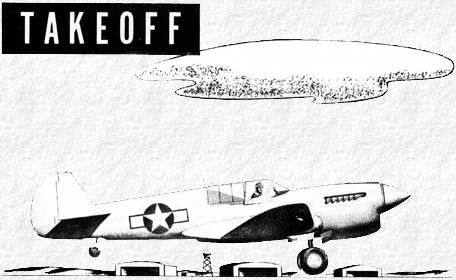|
Your takeoff in the P40, except
for greater torque, is not much different from that in
the AT-6.
Apply power smoothly, because a sudden burst of power
might make your airplane turn strongly to the left. Even
with smooth application of power the airplane tends to
swing to the left. Compensate for this tendency with firm
use of right rudder.
Don't force the tail up violently in the early stages
of the takeoff run. This makes you lose the use of the
steerable tailwheel before you gain rudder control.
During takeoff, torque tends to make the left wing drop;
compensate with right aileron.
Follow this takeoff procedure:
1. Select a reference
point on the horizon that you can keep clearly in sight
during the takeoff.
2. Move the throttle forward steadily and evenly to 45" Hg. (40" Hg. for Grade 91). Don't joggle the throttle. Keep your hand on the throttle until you are well in the air.
|
3. As soon as you have
sufficient speed, get the tail up slightly. Don't take
off in a 3-point position.
4. Keep the airplane
going straight down the runway by use of the rudder
alone. Use brakes only in emergency.
5. Allow the airplane to
fly itself off the ground with smooth back pressure on
the stick.
6. Brake wheels and
raise the landing gear as soon as you cannot make a
wheels-down landing on the remainder of the runway.
Adjust the trim tabs to ease pressure on the controls. As
soon as the wheels are up and locked, check with the hand
hydraulic pump and return the landing gear selector
handle to NEUTRAL.
7. Reduce the throttle
to 35" Hg. (33" Hg. for Grade 91 fuel) and 2500 rpm for
climbing as soon as you are definitely airborne.
Note: If the flaps are used for takeoff, don't
raise them until you have reached 500 feet.
|



